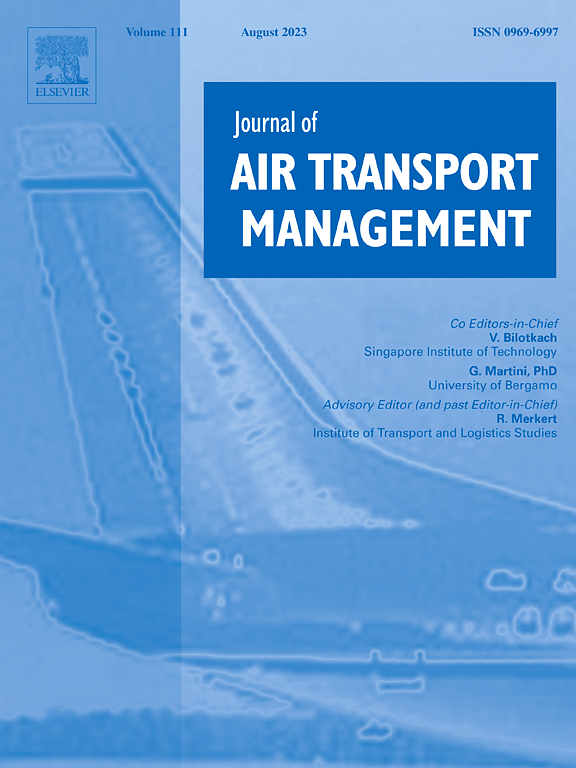Challenges in urban air mobility implementation: A comparative analysis of barriers in Germany and the United States
IF 3.6
2区 工程技术
Q2 TRANSPORTATION
引用次数: 0
Abstract
Urban Air Mobility (UAM) is a transport system enabling the movement of people and goods within urban areas using electric vertical take-off and landing (eVTOL) aircraft. Nonetheless, this concept remains an emerging technology with various challenges that can hinder its implementation. This research introduces a Multi-Criteria Decision-Making (MCDM) framework to prioritize barriers to UAM implementation in Germany and the USA. We identify 26 barriers across technological, economic, social, environmental, and operational aspects through a comprehensive literature review and expert interviews. Using the Fuzzy Best-Worst Method (FBWM), we determine the weight of each barrier based on input from industry and academic experts in Germany and the USA. Our findings reveal that economic aspects pose the greatest challenge in Germany, followed by social, operational, technological, and environmental aspects. In the USA, operational aspects are the most significant, followed by technological, economic, social, and environmental aspects. The operational aspect shows the largest difference between the two countries, while the environmental aspect shows the least. Globally, the top three barriers in Germany are price affordability, investment uncertainty, and user acceptance concerns. In the USA, the top three barriers are airspace utilization challenges, remote/autonomous operations, and system safety and cybersecurity issues, which rank tenth, twelfth, and sixteenth, respectively, in Germany. We also discuss the potential implications of our findings, offering strategies to effectively address high-priority barriers.
城市空中交通实施的挑战:德国和美国障碍的比较分析
城市空中交通(UAM)是一种使用电动垂直起降(eVTOL)飞机在城市区域内实现人员和货物移动的运输系统。尽管如此,这一概念仍然是一项新兴技术,面临各种挑战,可能会阻碍其实现。本研究引入了一个多标准决策(MCDM)框架,以优先考虑德国和美国实施UAM的障碍。通过全面的文献回顾和专家访谈,我们确定了技术、经济、社会、环境和运营方面的26个障碍。使用模糊最佳-最差法(FBWM),我们根据德国和美国的工业和学术专家的输入确定每个障碍的权重。我们的研究结果表明,经济方面是德国面临的最大挑战,其次是社会、运营、技术和环境方面。在美国,运营方面是最重要的,其次是技术、经济、社会和环境方面。两国在操作方面的差异最大,而在环境方面的差异最小。从全球来看,德国的三大障碍是价格承受能力、投资不确定性和用户接受度问题。在美国,前三大障碍分别是空域利用挑战、远程/自主操作以及系统安全和网络安全问题,在德国分别排在第十位、第十二位和第十六位。我们还讨论了我们研究结果的潜在含义,提供了有效解决高优先级障碍的策略。
本文章由计算机程序翻译,如有差异,请以英文原文为准。
求助全文
约1分钟内获得全文
求助全文
来源期刊

Journal of Air Transport Management
TRANSPORTATION-
CiteScore
12.40
自引率
11.70%
发文量
97
期刊介绍:
The Journal of Air Transport Management (JATM) sets out to address, through high quality research articles and authoritative commentary, the major economic, management and policy issues facing the air transport industry today. It offers practitioners and academics an international and dynamic forum for analysis and discussion of these issues, linking research and practice and stimulating interaction between the two. The refereed papers in the journal cover all the major sectors of the industry (airlines, airports, air traffic management) as well as related areas such as tourism management and logistics. Papers are blind reviewed, normally by two referees, chosen for their specialist knowledge. The journal provides independent, original and rigorous analysis in the areas of: • Policy, regulation and law • Strategy • Operations • Marketing • Economics and finance • Sustainability
 求助内容:
求助内容: 应助结果提醒方式:
应助结果提醒方式:


